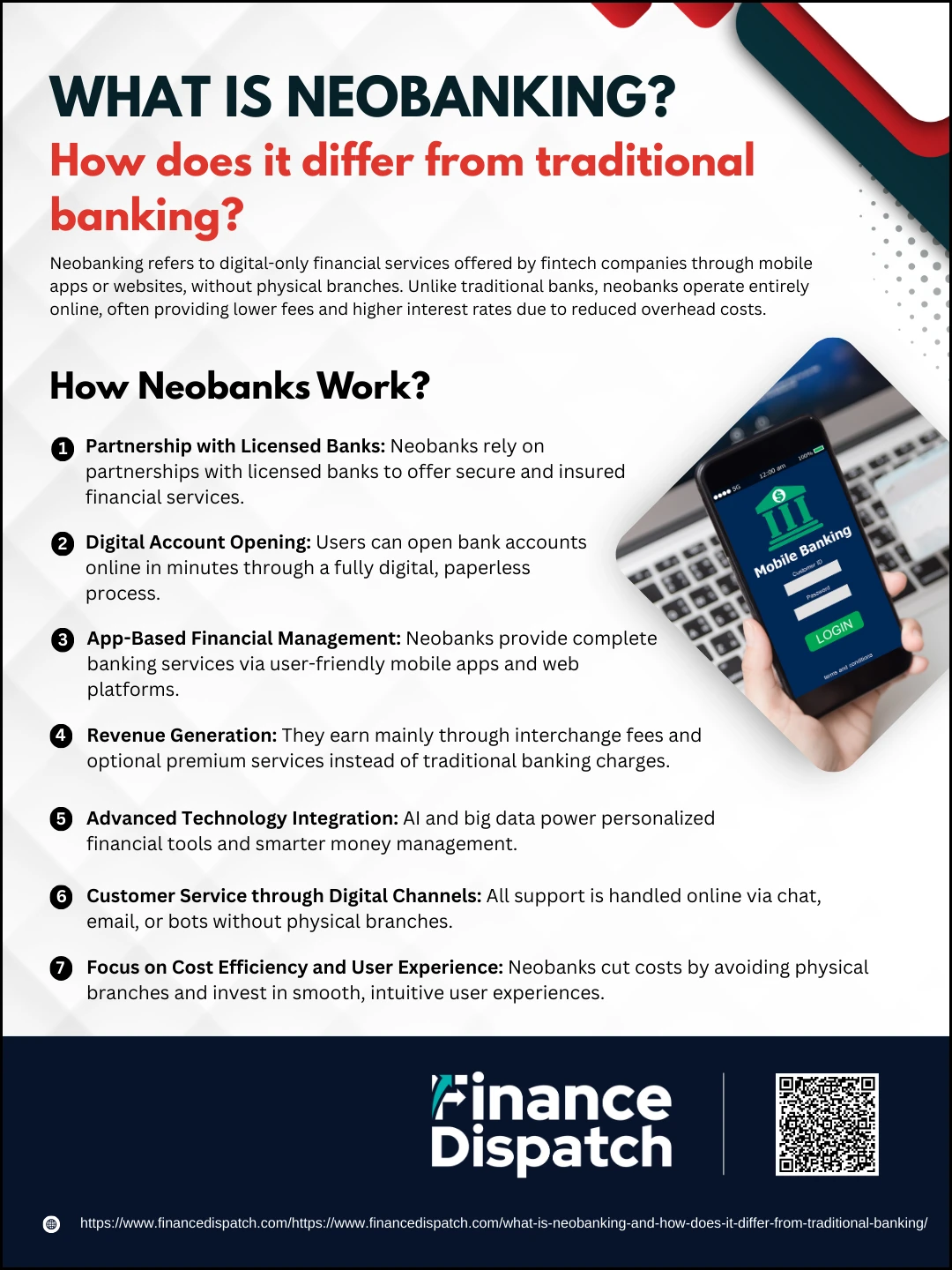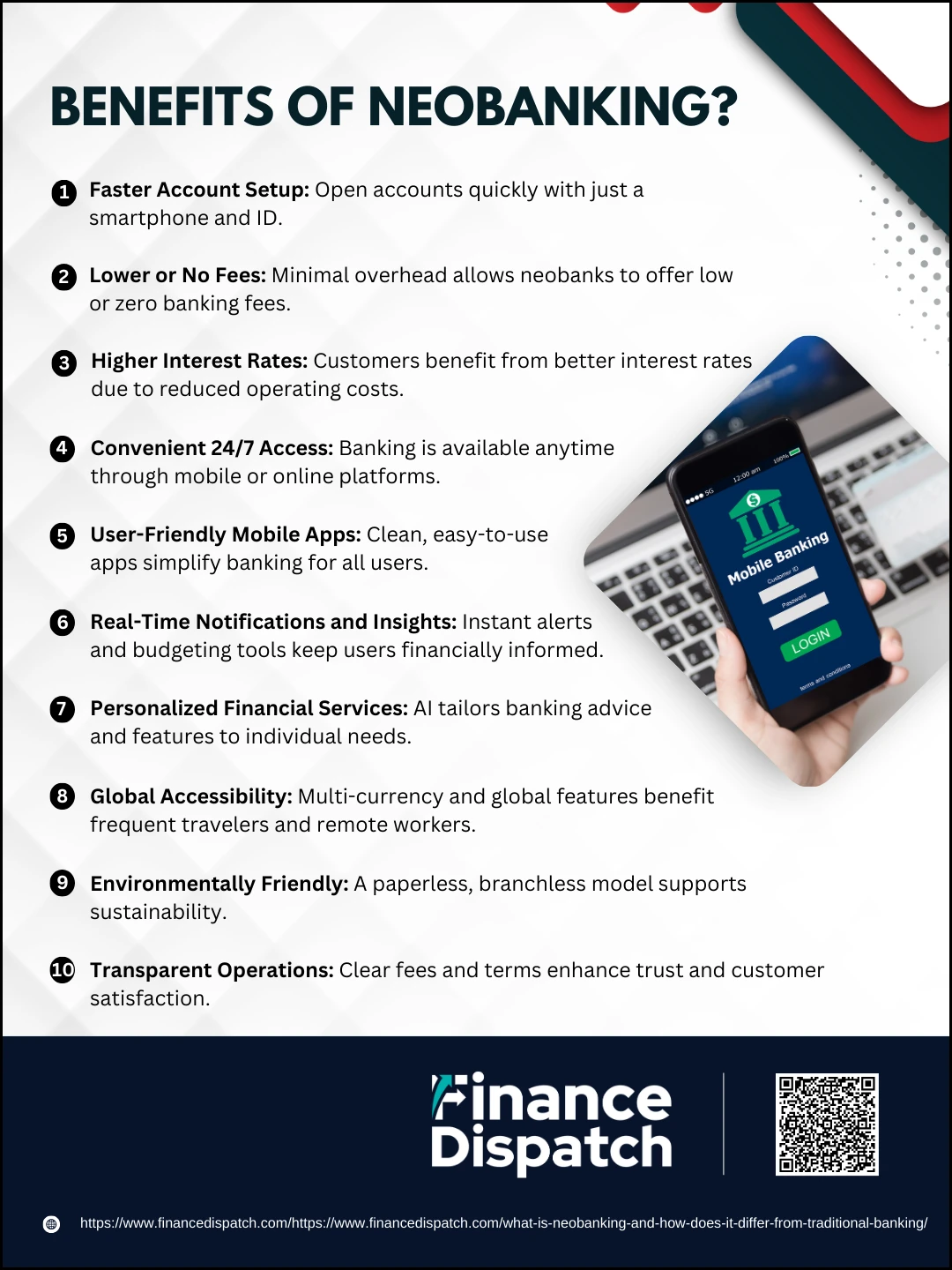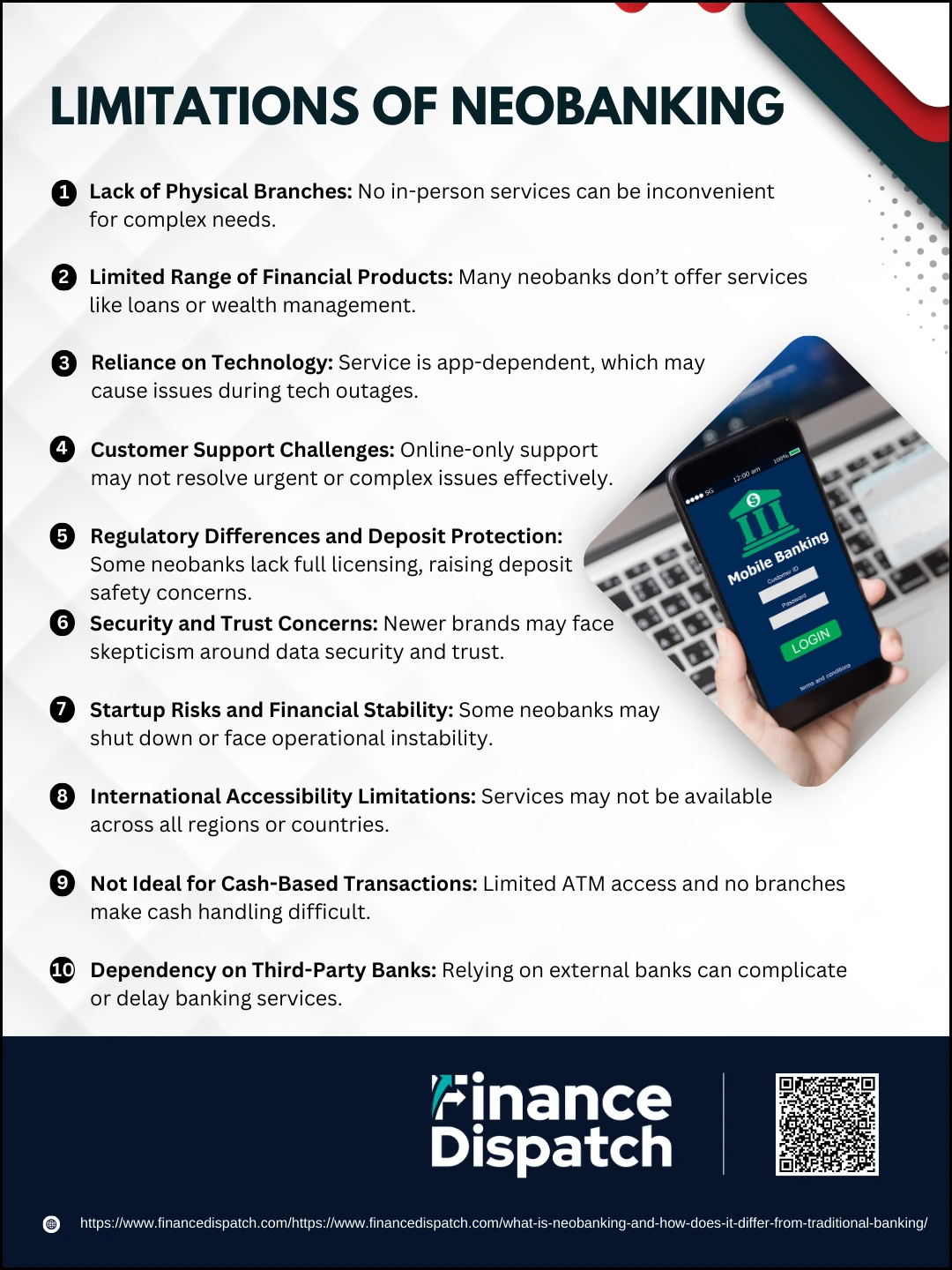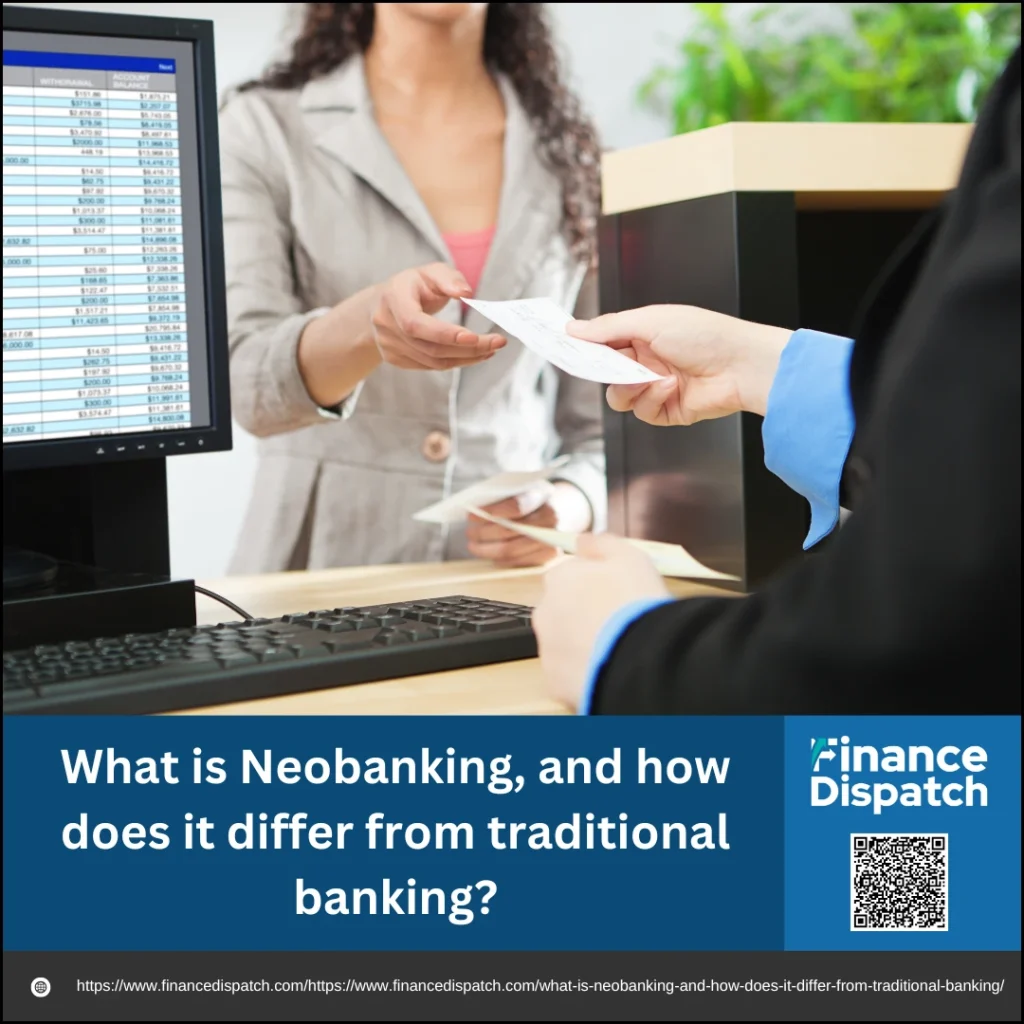In an age where digital transformation touches every part of our lives, banking has undergone one of its most remarkable evolutions. Neobanking, a modern approach to financial services, offers a fully digital banking experience without the need for physical branches. Designed to meet the demands of tech-savvy consumers, neobanks prioritize convenience, lower costs, and personalized services through mobile apps and online platforms. In contrast, traditional banks, with their long-standing history and physical presence, continue to provide a broader range of financial services but often with higher fees and slower processes. This article explores what neobanking is, how it works, and the fundamental differences that set it apart from traditional banking.
What is Neobanking?
Neobanking refers to a new form of banking that operates entirely online without any physical branches. These digital-first financial institutions offer services such as checking and savings accounts, money transfers, budgeting tools, and sometimes loans, all through mobile apps or web platforms. Unlike traditional banks, neobanks are built on modern technology frameworks, allowing them to provide faster, more convenient, and often cheaper banking experiences. Some neobanks operate independently with their own banking licenses (full-stack neobanks), while others partner with traditional banks to deliver services (front-end-focused neobanks). Their user-centric approach and lower operational costs make neobanks an attractive option for individuals seeking seamless and accessible financial management.
 How Neobanks Work
How Neobanks Work
Neobanks have revolutionized the way banking services are delivered by removing the need for physical branches and focusing entirely on digital platforms. They offer streamlined services through mobile apps and websites, providing customers with easy, fast, and often more affordable access to banking. Let’s take a closer look at how neobanks operate:
1. Partnership with Licensed Banks
Most neobanks do not have a full banking license of their own. Instead, they form partnerships with traditional, fully licensed banks to handle critical banking operations such as holding customer deposits, issuing cards, and providing deposit insurance through institutions like the FDIC (in the U.S.). This arrangement allows neobanks to offer safe and secure banking services without directly dealing with complex banking regulations.
2. Digital Account Opening
Opening an account with a neobank is a quick, paperless process that typically takes only a few minutes. Customers can complete the onboarding directly through the neobank’s app or website by submitting basic identification documents and completing electronic verification steps. This removes the hassle of visiting a branch, filling out extensive paperwork, or waiting for manual approvals.
3. App-Based Financial Management
Neobanks focus heavily on user-friendly digital interfaces, enabling customers to manage all their banking needs through an app or web portal. Customers can check their balances, view transaction histories, transfer funds, set up direct deposits, pay bills, and even access financial management tools like savings goals or budgeting calculators—all from the convenience of their smartphones.
4. Revenue Generation
Unlike traditional banks that heavily rely on service charges and loan interests, neobanks generate most of their revenue through interchange fees—the small charges merchants pay when customers use their debit cards. Some neobanks also offer premium accounts with additional features, subscription plans for extra services, or partnerships with third-party financial providers to broaden their income sources without burdening users with heavy fees.
5. Advanced Technology Integration
Technology is at the heart of neobanking. Neobanks use artificial intelligence (AI), machine learning, and big data analytics to deliver highly personalized services, such as predictive budgeting advice, spending insights, and custom financial product recommendations. These tools help users manage their money smarter, offering a level of personalization that traditional banks often cannot match.
6. Customer Service Through Digital Channels
Since neobanks lack physical branches, all customer service interactions occur through digital means. Users can reach out to customer support via live chat within the app, email, or through AI-powered chatbots. Many neobanks have invested heavily in making their digital customer service fast, intuitive, and available 24/7, addressing user issues without the need for in-person meetings or long wait times.
7. Focus on Cost Efficiency and User Experience
With no branch network to maintain, neobanks save significantly on operational costs. These savings are passed on to customers in the form of lower fees, better interest rates, and often free services like account maintenance or ATM access. Their lean and technology-driven structure allows them to invest more into enhancing the user experience, ensuring the app is smooth, intuitive, and packed with useful features.
What is Traditional Banking?
Traditional banking refers to the long-established system of financial services provided through physical branch networks, where customers interact face-to-face with bank staff for account management, financial advice, loans, deposits, and other services. These banks are fully licensed, heavily regulated institutions that have been central to economic life for centuries, offering a broad range of financial products beyond basic savings and checking accounts, including mortgages, credit cards, investment services, and wealth management. Despite offering online banking options in recent years, traditional banks still maintain a strong emphasis on in-person services, building long-term relationships with customers through personalized support, branch accessibility, and trusted reputations built over decades.
Key Differences between Neobanks and Traditional Banks
While both neobanks and traditional banks offer financial services like savings accounts and money transfers, their operational models and customer experiences are fundamentally different. Neobanks rely entirely on digital platforms, offering speed, lower costs, and tech-driven personalization, whereas traditional banks combine in-person and online services, supported by extensive branch networks and decades of regulatory stability. Understanding these key differences can help consumers choose the banking solution that best fits their needs.
Here’s a side-by-side comparison:
| Aspect | Neobanks | Traditional Banks |
| Physical Presence | No physical branches; fully digital operations via apps and websites | Operate physical branches alongside online services |
| Licensing and Regulation | May lack full banking licenses; often partner with licensed banks | Fully licensed and heavily regulated institutions |
| Fees and Costs | Lower or no fees due to reduced operational expenses | Higher fees for account maintenance, services, and transactions |
| Range of Services | Focus on basic banking: savings, checking, money transfers, budgeting tools | Wide range of services: loans, mortgages, investments, advisory |
| Customer Service | Online-only through apps, chatbots, and emails | In-person support at branches plus online and phone support |
| Speed of Service | Instant account opening, real-time transactions | Account processes and approvals often take longer |
| Technology Usage | Advanced use of AI, machine learning, and mobile-first designs | Slower to adopt new technologies, especially in older institutions |
| Deposit Insurance | Insured via partner banks (where applicable) | Direct deposit insurance under national regulations |
| Target Audience | Tech-savvy individuals and small businesses | Broad demographic, including individuals and large businesses |
| Trust and Stability | Newer players, perceived as less stable by some | Long-standing reputation and public trust |
 Benefits of Neobanking
Benefits of Neobanking
Neobanking has emerged as a revolutionary force in the financial world, offering a refreshing alternative to traditional banking models. By leveraging cutting-edge technology and operating entirely online, neobanks deliver a seamless and efficient banking experience tailored to modern lifestyles. Their focus on user convenience, lower fees, and smart financial management tools makes them particularly appealing to younger generations and tech-savvy consumers. Let’s explore the key benefits that neobanking brings to the table:
1. Faster Account Setup
Opening a bank account with a neobank can typically be completed within minutes using a smartphone or computer. This streamlined, paperless process removes the traditional hurdles of visiting a branch, filling out extensive forms, or waiting for manual approvals.
2. Lower or No Fees
Neobanks operate with minimal overhead costs, allowing them to offer checking and savings accounts with no monthly maintenance fees, free domestic transfers, and transparent pricing. Customers can avoid many of the hidden or confusing charges that are often associated with traditional banks.
3. Higher Interest Rates
Because neobanks save money by not operating physical locations, they often pass these savings on to customers through more competitive interest rates on savings and fixed deposits. Some neobanks even offer reward-based savings programs to encourage healthy financial habits.
4. Convenient 24/7 Access
Neobanking services are available around the clock through highly intuitive mobile apps and online portals. Whether it’s transferring money, checking balances, or paying bills, customers can manage their entire banking experience without being restricted to branch hours.
5. User-Friendly Mobile Apps
Neobanks invest heavily in creating sleek, modern apps that prioritize ease of use. With clean interfaces, simple navigation, and personalized dashboards, users can perform complex banking tasks quickly, even if they aren’t financially or technologically sophisticated.
6. Real-Time Notifications and Insights
Every transaction, deposit, or financial update is instantly communicated through push notifications. Additionally, many neobanks offer spending breakdowns, budgeting suggestions, and alerts that help customers track financial goals in real-time.
7. Personalized Financial Services
By analyzing customer behavior through AI and machine learning, neobanks can offer highly customized experiences. From recommending savings plans to setting spending limits and offering tailored investment advice, neobanks deliver financial solutions that align with individual goals.
8. Global Accessibility
Many neobanks support multi-currency wallets, low-cost international transfers, and even global debit cards. This makes neobanks especially beneficial for digital nomads, frequent travelers, freelancers, and international businesses.
9. Environmentally Friendly
With no need for physical branches, excessive paperwork, or printed statements, neobanks contribute to reduced carbon emissions and waste. Their digital-first model appeals to eco-conscious consumers who value sustainability alongside financial convenience.
10. Transparent Operations
Unlike traditional banks that often have hidden fees and complex terms, neobanks strive to maintain transparency. Customers receive clear information about fees, interest rates, and account policies upfront, fostering greater trust and satisfaction.
 Limitations of Neobanking
Limitations of Neobanking
While neobanks offer convenience, low fees, and cutting-edge technology, they are not without their drawbacks. As digital-only financial institutions, neobanks may not always meet the needs of every customer, especially those who prefer traditional services or require complex financial products. It’s important to understand these limitations before fully committing to a neobank as your primary banking solution.
1. Lack of Physical Branches
Neobanks operate entirely online, meaning there are no physical locations for in-person assistance. For customers who prefer face-to-face interaction, especially for handling complex transactions or sensitive financial matters, this can be a significant drawback.
2. Limited Range of Financial Products
While traditional banks offer a full suite of financial services—such as mortgages, wealth management, business loans, and insurance—neobanks generally focus on basic banking functions like savings, checking, and payments. Customers needing a broader range of services may find neobanks insufficient.
3. Reliance on Technology
Neobanks depend heavily on mobile apps and internet access. If there are app malfunctions, server outages, or if a user is not tech-savvy, accessing and managing their account can become frustrating or even impossible temporarily.
4. Customer Support Challenges
Although many neobanks offer chat or email support, the lack of in-person service can make resolving complex issues slower and less satisfactory. In critical situations, such as unauthorized transactions or urgent financial needs, digital-only support may feel inadequate.
5. Regulatory Differences and Deposit Protection
Not all neobanks have full banking licenses. Some rely on partner banks for deposit insurance protection, while others may not offer the same level of security as traditional banks. This can create concerns about the safety of deposits in the event of neobank failures or financial crises.
6. Security and Trust Concerns
Although neobanks implement strong cybersecurity measures, some consumers remain hesitant to trust newer, lesser-known institutions with their financial data. The absence of a long-established reputation can lead to doubts about reliability and data protection.
7. Startup Risks and Financial Stability
As relatively young companies, some neobanks may face operational challenges, funding shortages, or even bankruptcy. Customers tied to such platforms could experience disruptions or forced transitions to partner banks if the neobank shuts down or is acquired.
8. International Accessibility Limitations
While many neobanks offer multi-currency accounts and international services, some may limit their operations to specific countries or regions. This can pose challenges for global travelers or expatriates seeking widespread financial access.
9. Not Ideal for Cash-Based Transactions
For users who frequently deal with cash—whether deposits, withdrawals, or handling cash-based businesses—neobanks present limitations. Without physical branches or a strong ATM network, cash handling becomes more cumbersome compared to traditional banks.
10. Dependency on Third-Party Banks
In cases where neobanks lack a full banking license, they are dependent on third-party banks for critical services like holding deposits and providing insurance. This reliance can sometimes lead to added layers of complexity and slower resolution of issues for customers.
Why People Are Switching to Neobanks
People are increasingly switching to neobanks because they offer a faster, simpler, and more cost-effective way to manage finances. In a world driven by smartphones and digital convenience, consumers are drawn to the seamless experience of opening accounts, making payments, and tracking expenses—all through user-friendly mobile apps. Neobanks eliminate the hassle of visiting physical branches, reduce banking fees, and provide real-time insights into spending habits. Features like instant notifications, budgeting tools, and personalized financial recommendations resonate strongly with tech-savvy users, freelancers, and younger generations who value flexibility and control over their money. As trust in digital services grows, so does the appeal of neobanks as a modern banking alternative.
Things to Consider Before Choosing a Neobank
Before opening an account with a neobank, it’s essential to assess whether it aligns with your financial needs and lifestyle. While neobanks offer numerous advantages like low fees and digital convenience, they may not be the best fit for everyone. Evaluating key factors beforehand can help you make an informed decision and avoid potential frustrations down the line.
Things to Consider Before Choosing a Neobank
1. Deposit Insurance: Ensure the neobank offers protection for your money through FDIC (U.S.) or equivalent insurance, typically via a partner bank if the neobank itself isn’t fully licensed.
2. Scope of Services: Check whether the neobank provides all the services you need, such as bill payments, loans, savings tools, or international transfers.
3. Customer Support Quality: Look into how easily you can reach customer support and what channels they offer (live chat, email, and phone). Quick, responsive service is crucial during issues.
4. Technology Compatibility: Make sure the neobank’s app or website is compatible with your devices and offers a user-friendly interface that suits your preferences.
5. Security Features: Consider the strength of security measures like two-factor authentication, biometric login, data encryption, and fraud monitoring systems.
6. Fee Structure Transparency: Review all possible fees—monthly charges, ATM usage, international transfers—to avoid unexpected costs later on.
7. Reputation and Stability: Research the neobank’s track record, financial backing, user reviews, and whether it has experienced outages, legal issues, or acquisition rumors.
8. Accessibility and ATM Network: Consider how easy it is to withdraw cash or deposit funds, especially if you still rely on cash occasionally.
9. Availability in Your Region: Some neobanks are only available in specific countries or markets, so confirm eligibility and service support for your location.
The Future of Neobanking
The future of neobanking looks both promising and dynamic, as digital finance continues to evolve alongside consumer expectations. With the rise of artificial intelligence, machine learning, and embedded finance, neobanks are expected to offer even more personalized, predictive, and integrated financial experiences. As competition intensifies, we’re likely to see greater innovation in services like automated savings, real-time credit decisions, cryptocurrency integration, and financial wellness tools. However, the path forward may also include challenges such as tighter regulations, funding constraints, and market consolidation through mergers or acquisitions. Ultimately, neobanks are not just reshaping how people bank—they’re redefining what customers expect from financial institutions in the digital age.
Conclusion
Neobanking has emerged as a powerful alternative to traditional banking, offering a faster, more affordable, and digitally focused experience tailored to the needs of modern users. While neobanks excel in convenience, innovation, and user-friendly features, they also come with limitations such as limited services and the absence of in-person support. As financial habits shift toward mobile-first solutions, neobanks are likely to play an increasingly important role in the future of banking. However, the decision to switch should be based on individual needs, considering both the advantages and potential drawbacks. For many, neobanks represent not just a new way to bank—but a smarter, more personalized financial journey.



